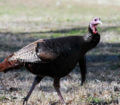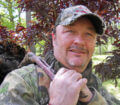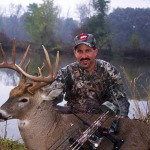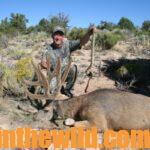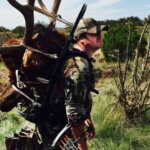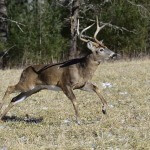Editor’s Note: Avid turkey hunter Steve Coon, a police officer from Arnold, Missouri, has been a longtime member of Mark and Terry Drury’s Drury Outdoors (www.druryoutdoors.com).
I think that turkeys get a bad rap. Sometimes they’re labeled as bad turkeys when they’re really not. Sometimes I think the hunter makes mistakes, or the hunter just doesn’t know how to bring a gobbler within gun range. Here are some tips that may help you take bad birds and also good birds:
 * Don’t attempt to call in a turkey with only one call, just like a fisherman doesn’t go fishing with only one lure. I suggest you always take a slate call, a box call, a mouth diaphragm call, a push-button call and any other type device that you can use to call in a turkey with you when you’re hunting. Regardless of how much you like one particular call, on certain days some turkeys won’t gobble to that call, but they will gobble to different calls. So, learn to use as many different types of turkey calls as you can. Sometimes I’ve used a slate-and-glass call and gotten no response. I’ve used a diaphragm call before and not had a turkey gobble. But then when I’ve pulled out my box call, a turkey may gobble his brains out less than 100 yards away. So, learn to use as many different types of turkey calling devices as you can.
* Don’t attempt to call in a turkey with only one call, just like a fisherman doesn’t go fishing with only one lure. I suggest you always take a slate call, a box call, a mouth diaphragm call, a push-button call and any other type device that you can use to call in a turkey with you when you’re hunting. Regardless of how much you like one particular call, on certain days some turkeys won’t gobble to that call, but they will gobble to different calls. So, learn to use as many different types of turkey calls as you can. Sometimes I’ve used a slate-and-glass call and gotten no response. I’ve used a diaphragm call before and not had a turkey gobble. But then when I’ve pulled out my box call, a turkey may gobble his brains out less than 100 yards away. So, learn to use as many different types of turkey calling devices as you can.
* Learn as many different types of calls as you can like the cluck, the purr, cutting, a tree call, a lost call, a young gobbler’s squealing call, scratching in the leaves and flapping a wing. Any sound that a hen turkey makes may be the one sound that’s required to get that gobbler to come in close enough for you to take a shot, although probably 50 percent of the gobblers you hear gobble in the mornings will come to a simple hen yelp.
* Know when to use what call. One of the most-effective calls is often no call at all. Understanding when to stop calling may bring you as many birds in as any call you can use. When a turkey is gobbling and coming to you, there’s no reason to call to him. That gobbler already has pinpointed your location. All you have to do is wait for him to show up.
 * Mix and match your camo. Before green-up, you may want to wear Mossy Oak (www.mossyoak.com) Bottomland or Mossy Oak Treestand. But when green-up arrives, think about Mossy Oak Bottomland for pants, and Mossy Oak Obsession or Mossy Oak Break-Up Country for your top. I usually carry two or three different Mossy Oak patterns with me whenever I go turkey hunting, especially when I’m out of state. Then I can mix and match the shirts and pants to suit the type of terrain where I’ll be hunting.
* Mix and match your camo. Before green-up, you may want to wear Mossy Oak (www.mossyoak.com) Bottomland or Mossy Oak Treestand. But when green-up arrives, think about Mossy Oak Bottomland for pants, and Mossy Oak Obsession or Mossy Oak Break-Up Country for your top. I usually carry two or three different Mossy Oak patterns with me whenever I go turkey hunting, especially when I’m out of state. Then I can mix and match the shirts and pants to suit the type of terrain where I’ll be hunting.
* Hunt at times when other hunters don’t hunt. Most turkey hunters hunt on the weekends. If they hunt during the week, they’re usually in the woods before daylight until about 10:00 am and then leave for work. If the state you’re hunting in has a turkey season that closes at noon, then hunt from 9:00 am-12:00 noon. If the state that you’re hunting in has an all-day turkey season, hunt from 10:00 am until dark. If you hunt when other hunters aren’t hunting – both times and days – you may have a chance to hear and take a gobbler that other hunters won’t hear and won’t see.
* Put a riflescope on your turkey shotgun. You can use a red dot scope or a scope with reticules in it. Make sure you pattern your shotgun with that scope to know what your pattern looks like from 10-50 yards.
 * Learn from other hunters what they’ve done to try to take a turkey that’s been given a name by other people. Make sure you don’t make the same mistakes those hunters have. Use a different tactic, and go to the turkey from a different direction.
* Learn from other hunters what they’ve done to try to take a turkey that’s been given a name by other people. Make sure you don’t make the same mistakes those hunters have. Use a different tactic, and go to the turkey from a different direction.
* Use your woodsmanship to determine where the turkey is going if you have a bad bird that you can’t take by calling to, when he’s going to that spot, why he’s going to that place, and where he’ll go after he leaves that location. Then, take a stand along his travel route to harvest him.
To learn more about turkey hunting, check out John E. Phillips’ print, Audible and Kindle turkey books at https://johninthewild.com/books/#turkey. For a free copy of John E. Phillips’ “The Turkey Gobbler Getter Manual,” go to https://johninthewild.com/free-books/.

